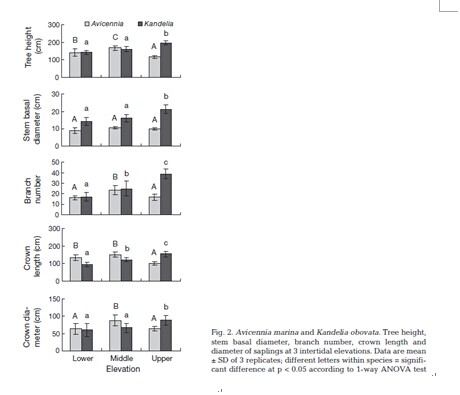Ya P. Chen, Yong Ye.Marine Ecology Progress Series,2013. 482: 107-118.
Differences in growth and physiological characteristics of saplings ofAvicennia marinaandKandelia obovatawere compared among 3 intertidal elevations. Growth performance of A. marina generally followed the order of the middle > lower > upper elevation. At the middle elevation,A. marinahad maximum values of tree height, branch number, crown length and diameter, shoot biomass and shoot to root biomass ratio (S:R). Differently, K. obovata exhibited best growth at the upper elevation, followed by the middle and lower elevation. Except for shoot biomass and S:R, all growth parameters ofK. obovatashowed a tendency to decline continuously with decreasing elevation. These different responses between the 2 species indicated thatA. marinais more tolerant to low elevation thanK. obovata. Decreasing elevation did not compromise gas exchange ofA. marinaleaves, while net photosynthetic rate, transpiration rate, stomatal conductance and intercellular CO2concentration ofK. obovataleaves declined sharply as the elevation decreased. Leaf chlorophyll (chl) a:b ratio and contents of chla, total chl and total carotenoid showed no significant differences among elevations for both species. With decreasing elevation, activities of superoxide dismutase and peroxidase increased significantly for both species, while significant increase in malonaldehyde contents was only recorded forK. obovata. With decreasing elevation, proline accumulation in leaves was accelerated for A. marina but not forK. obovata. These physiological responses also confirmed that A. marina is more tolerant to low intertidal elevation thanK. obovata.


